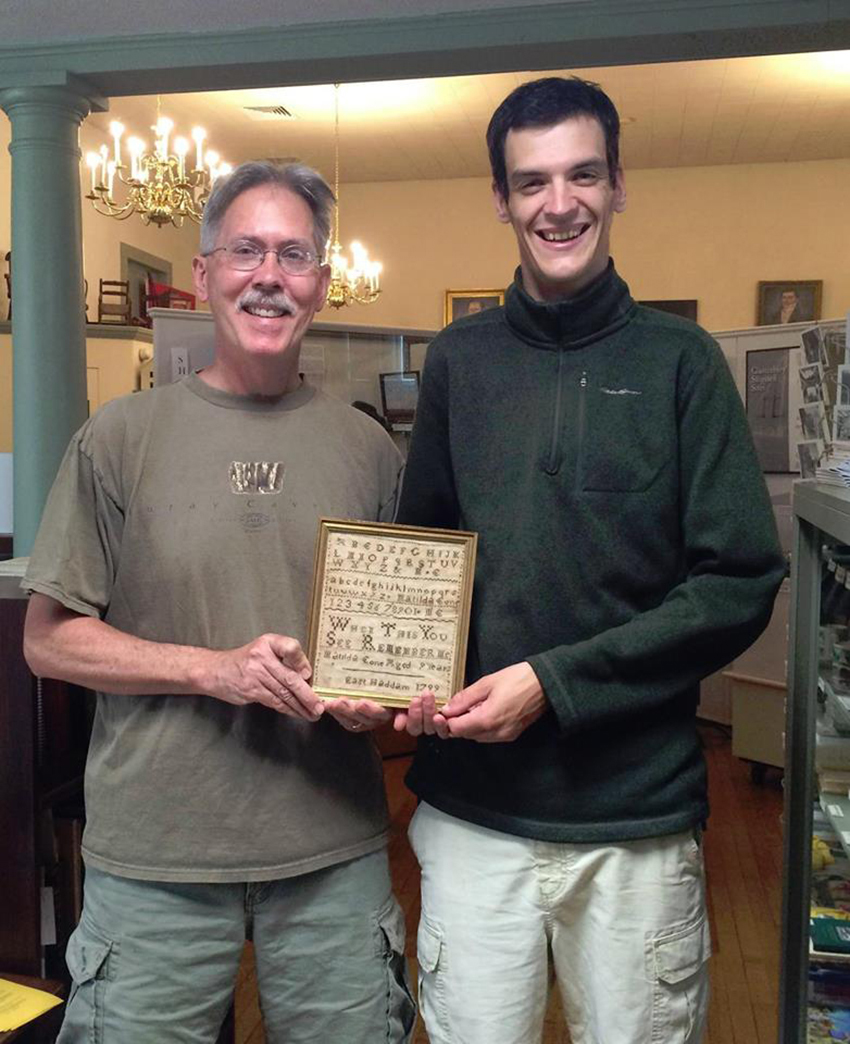
Antiques dealer Jeff Pudlinski of County Seat Antiques, Litchfield, Conn., shown right, with Historical Society of Glastonbury executive director James Bennett and the returned 1799 sampler by Matilda Cone.
GLASTONBURY, CONN. — It is never a “good news” day at Antiques and The Arts Weekly when a stolen item report comes in, but it is excellent news anytime when one of those articles results in the recovery of that treasure — and such was the case with a late Eighteenth Century sampler that went missing from the Welles Shipman Ward House, a property maintained by the Historical Society of Glastonbury, in the fall of 2011.
The Welles Shipman Ward House was built in 1755 not far from the Connecticut River, and is frequently used for functions sponsored by the society. According to James Bennett, the society’s executive director, the sampler is titled “Remember Me” and was stitched by Matilda Cone in 1799.
The sampler reads, “When this you see / remember me / Matilda Cone, Aged 9 years / East Haddam 1799. According to local historical information, the child disappeared, and was never found. Then, adding further insult, the sampler, too, disappeared 213 years later.
That is, until Litchfield, Conn., antiques dealer Jeff Pudlinski went to Mays at Brimfield this past September and bought a small, sweet — or so he thought — Connecticut sampler from a dealer exhibiting there. “I liked the fact that it identified the girl and the town she was from and was dated 1799,” said Pudlinski. “I collect early Connecticut samplers that have the towns mentioned, so thought, hey, great — a lucky find after trekking here for days and finding nothing. I paid retail, but what the heck, it was a keeper — or so I thought,” said Pudlinski.
Taking it home that night, he decided to research Matilda Cone to see what else he could learn about her early Connecticut family. “Just for fun, right?” he recalled. “That’s when things got crazy. Up pops an old article noting that this sampler had been stolen from a museum in 2011. What? Not only had the sampler been stolen, but per records, the maker herself had disappeared shortly after she made it. Creepily so, it was stitched in large letters: ‘When This You See, Remember Me.’ I freaked. Obviously, like the majority of us, I’m not one to buy or keep stolen goods ever, so I could barely sleep.”
Pudlinski said he drove two hours back to Brimfield at daybreak the next day with the info in hand to let the dealer know that he would be calling the historical society and making arrangements to return it. He also hoped, of course, to get his purchase price refunded and see if, with the dealer’s help, he could figure out where the sampler had been the past four years. “Of course, due to the rain that came in later Thursday and onwards, he [the dealer] was long gone as were many others,” said Pudlinski, “Moral of this story — don’t worry about random receipts with no names, take contact info with every purchase and pay by check.”
“Regardless,” he continued, “I still had work to do. As soon as they opened, I called the historical society, explained the crazy story and delivered it safely into their stunned but happy arms before lunch. Frankly, I couldn’t get it out of my hands fast enough, given the whole bizarre episode. The good news is that even though it totally freaked me out, of all the buyers at Brimfield, I think I was meant to be the one who bought it and see that it would get home. And yes, Matilda, after a crazy and wild 24 hours, I will definitely ‘remember’ you.”
“The return of the sampler was a delightful surprise,” said Bennett. “Very seldom do such items find their way back to their owners. Luckily for the society, an honest man and an outstanding antiques dealer stumbled upon the sampler and returned it. When working with antiques, it is sometimes difficult to ascertain the honesty of those you are working with or their research. The society was blessed to have Jeff Pudlinski do his research and have the professional ethics to return the item. He refused any reward, delighting in the fact that the sampler was back home. The society wouldn’t think twice before engaging his professional help. We wish him much luck in the exciting and rewarding field of antiques.”

